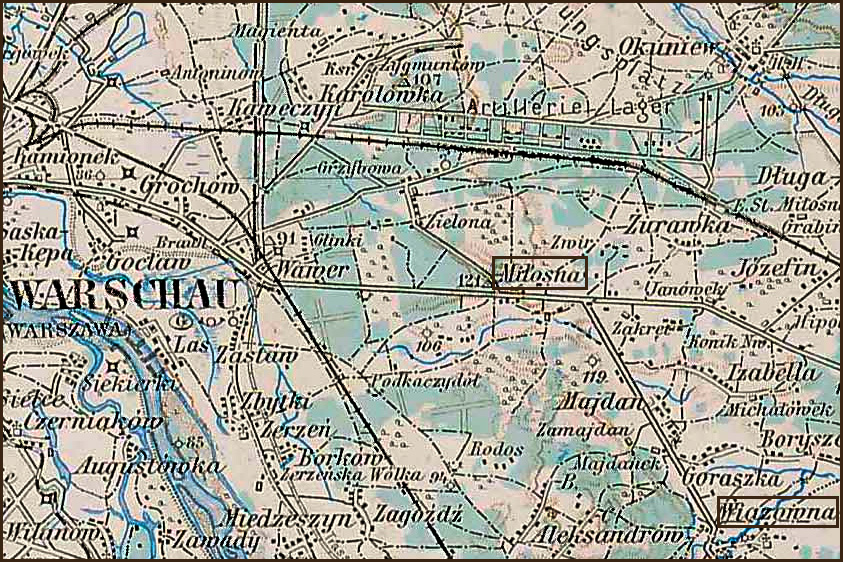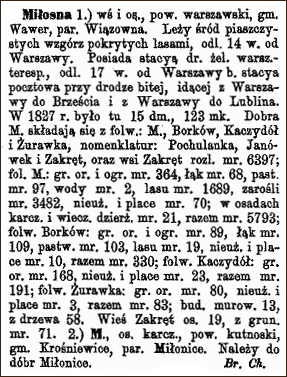The village of Miłosna is the location in Poland in which some of my Niedziałkowski ancestors may have been born. In particular, my great granduncle Jan Niedziałkowski was born there (according to his marriage record), and my great grandfather Teofil Niedziałkowski may also have been born there. I suspect my grandfather Kostanty Niedziałkowski was also born there.
Austrian Military Map of Miłosna Area – 1910Â
SOURCE: Third Military Mapping Survey of Austria-Hungary, Sheet 39-52, Varsó. Online http://lazarus.elte.hu/hun/digkonyv/topo/200e/39-52.jpg; downloaded 02 Oct 2008.
Słownik Geograficzny Entry for Miłosna
Source: Source: Sulimierski, Filip, Bronisław Chlebowski, and Władysław Walewski, eds., Słownik Geograficzny Królestwa Polskiego i Innych Krajów Słowiańskich (Geographical Dictionary of the Kingdom of Poland and other Slavonic Countries) – Warsaw 1885, Volume VI, page 440.
Click on the link for a PDF copy of the Słownik Geograficzny entry for Miłosna. Translated from the Polish, the entry reads:
Miłosna 1.) a village and settlement in Powiat [District] warszawski and gmina [township] Wawer; the parish is in Wiązowna. It lies in the middle of a sandy hill covered with forests, 14 versts [1 verst = 0.663 miles] distant from Warszawa. It possesses a railway station from Warszawa to Terespol, 17 versts from the Warszawa b. post office by a beaten track going from Warszawa to Brześć and from Warszawa to Lublin. In the year 1827 there were 15 homes and 123 residents here. The possessions of Miłosna consist of the folwarks [large manorial farmsteads]: Miłosna, Borków, Kaczydół, and Żurawka, nomenclature: Pochulanka, Janówek, and Zakręt, as well as the village of Zakręt, an open expanse of 6397 mórgs [in the Russian partition 1 mórg = 1.388 acres]; the Miłosna folwark includes 364 mórgs of arable land and gardens, 68 mórgs of meadows, 2 mórgs of water, 1689 mórgs of forests, 3482 mórgs of brush, 70 mórgs of unused land and squares; in the settlement there are 21 mórgs of clearcut and land lease, together there are 5793 mórgs; in the Borków folwark there are 89 mórgs of arable land and gardens, 109 mórgs of meadows,103 mórgs of pastures, 19 mórgs of forests, 10 mórgs of unused land and squares, together there are 330 mórgs; in the Kaczydół there are 168 mórgs of arable land and gardens, 23 mórgs of unused land and squares, together there are 191 mórgs; in the Żurawka folwark there are 80 mórgs of arable land, 3 mórgs of unused land and squares, together there are 83 mórgs; there are 13 brick buildings and 58 wooden buildings. The village of Zakręt has 19 settlers and 71 arable mórgs . 2.) M[iłosna] is a clearcut settlement in Powiat kutnoski and Gmina Krośniewice, the parish is in Miłonice. It is part of the property of Miłonice.
                                                  Br[onisław] Ch[lebowski]
The Family History Library has microfilmed the parish registers from Wiązowna, the parish to which the village of Miłosna belonged. I’ve ordered three of these films.
In the map, above, it is apparent how close Miłosna is to Warsaw. On one document, my grandfather claimed he was born in Warsaw. Given the close proximity of Miłosna to Warsaw, if my grandfather was actually born in Miłosna, it would be understandable why he would say he was born in Warsaw.
The maps of the Third Military Mapping Survey of Austria-Hungary and the entries in the Słownik Geograficzny were prepared at about the same time and make a good pair for studying places in and around the Congress Kingdom of Poland at the end of the 19th century and beginning of the 20th century, a time period when the Eastern European ancestors of present-day Americans left their homelands for the United States.
Copyright © 2008 by Stephen J. Danko





